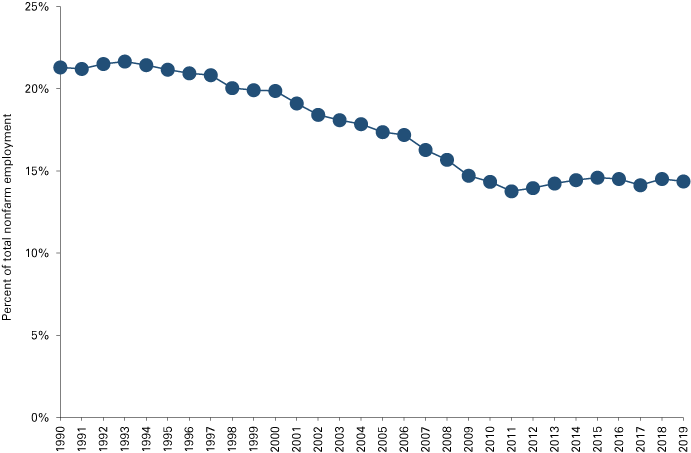Evansville forecast 2020

Professor of Economics and Provost, University of Southern Indiana
In the aftermath of the Great Recession, which lasted from December 2007 to June 2009, a growing body of research has documented the importance of household debt in explaining the trajectory of economic activity leading up to and during that economic downturn. Areas where households were heavily indebted relative to their income when the recession started experienced sharper declines in consumption and employment. The Federal Reserve has published interactive maps allowing users to explore the debt-to-income ratio by state, metropolitan statistical area and county for each year since 1999.
In the Evansville Metropolitan Statistical Area (Evansville MSA), the debt-to-income ratio increased from 0.794 to 1.137 between 1999 and 2018. During the time frame of the Great Recession, the debt-to-income ratio declined from 1.297 to 1.159. This was accompanied by declines in household spending, employment and output.
During 2019, relatively strong growth in both the transportation and warehousing and management of companies and enterprises sectors—combined with increases in personal income and announcements of future fixed investments—provide the basis for projecting increased employment, output and income in 2020.
Announcements in 2019 that will boost economic activity in the Evansville region in 2020 include a $1.3 billion expansion/upgrade by Toyota Motor Manufacturing, Indiana, Inc. to its plant in Gibson county, a solar project for the Evansville Airport to cover the entire short-term parking area, a $6.6 million foam packaging project at the Vanderburgh Industrial Park, a $30 million pilot plant at SABIC Innovative Plastics, and the $25 million to $30 million redevelopment of the 5th and Main Tower building in downtown Evansville. In addition, developments in the health care sector, such as the opening of an orthopedic hospital in Warrick County and a new clinic on the campus of the Stone Family Center for Health Sciences (which includes a focus on clinical research in partnership with the Indiana University School of Medicine), will serve to strengthen the significance of this sector as a driver of future economic activity and quality of life enhancements in the Evansville MSA.
Once all data are released for 2019, nominal personal income is estimated to have increased by 4.0 percent and real gross metro product is estimated to have increased by 2.2 percent.
In 2020, Evansville metro area real output is forecasted to increase by 1.3 percent, the number of jobs is projected to increase by 1,557, nominal personal income growth is forecasted to increase by 3.9 percent, while the unemployment rate is projected to be 2.9 percent.
The unemployment rate in the Evansville metro decreased from 3.6 percent in January 2019 to 2.7 percent in September 2019. There was also a decline in the national unemployment rate from 4.0 percent to 3.5 percent over the same time period. Job gains occurred primarily in the following sectors: transportation and warehousing, management of companies and enterprises, and real estate. The primary activities experiencing jobs losses were in retail trade and the administrative, support, waste management and remediation services sector.
The manufacturing sector continues to be an important base to metro area household incomes and consumer spending activity, even as the economy exhibits a long-term pattern of diversification away from manufacturing-industry dependence (see Figure 1).
Figure 1: Evansville metro manufacturing employment as a percent of total nonfarm employment

Note: 2019 data are for September.
Source: STATS Indiana, using U.S. Bureau of Labor Statistics and Indiana Department of Workforce Development data
As one of the most manufacturing-dependent metro areas in the nation, the Evansville economy was noticeably impacted by the Great Recession. Since 2007, Evansville’s manufacturing workforce has fallen by 7.1 percent, or about 1,800 workers—compared to a 2.0 percent reduction in Indiana’s manufacturing workforce over the same period. In 2019, manufacturing output continues to be a significant driver of economic activity, accounting for about 28 percent of the gross regional product in the Evansville regional economy. As Table 1 shows, the manufacturing sector accounts for 14.4 percent of employment in the Evansville metro.
Table 1: Manufacturing's percent of total employment, September 2019
| Category | Evansville metro | Indiana | U.S. |
|---|---|---|---|
| Manufacturing | 14.4% | 16.9% | 8.5% |
| Durables | 40.5% | 71.4% | 62.6% |
| Nondurables | 59.5% | 28.6% | 37.4% |
Source: STATS Indiana, using U.S. Bureau of Labor Statistics and
Indiana Department of Workforce Development data
Given the proportion of output that is sold outside the metro area, the economic vitality of the Evansville area is linked to the strength of the broader economy. As employment and demand for locally produced goods continue to surpass pre-recession levels, disposable income and output growth are expected to increase in 2020.
A widening gap between the Evansville economy and the U.S. economy with regard to the income growth trend over the past three decades highlights the importance of achieving higher rates of future output and employment growth. Strategies aimed at taking advantage of the manufacturing and health care industry clusters merit attention.



